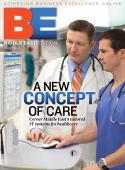Flying┬áfinish┬áFocusing on healthcare and retail is helping S. M. Wilson & Co. build and strengthen its specialist expertise, and develop its reputation in its chosen markets, project executive Bill Wagner tells Ruari McCallion. Nearly 90 years after it was established by Shouse McGarvey Wilson, S. M. Wilson & Co. remains in family hands; company president Scott Wilson is the founderÔÇÖs grandson. Most family companies barely survive three generations; that S. M. Wilson hasÔÇöand is growingÔÇöis testament to the drive, focus and determination that continues to breed true. It isnÔÇÖt based on doing the same things, regardless of circumstances; the company isnÔÇÖt afraid to move with the times.ÔÇ£S. M. Wilson moved from its original home in Granite City, Illinois, to St. Louis, Missouri, eight years ago,ÔÇØ says Bill Wagner, project executive, healthcare. ÔÇ£The original company was established on the steel industry, and we still have an important share in the industrial sector. But as we moved toward retail, healthcare and education, we found the geographic center of gravity was moving also. Missouri represents a growing economy for us as a business in all our sectors.ÔÇØ The move did not involve many miles, but it was a major step in WilsonÔÇÖs development. It is a growing company, with around 225 salaried employees; annual revenues are expected to exceed $500 million this yearÔÇöup from 2007, which isnÔÇÖt a bad performance in challenging economic circumstances. It has been led by strong growth in healthcare, which has overtaken retail as WilsonÔÇÖs largest sector.ÔÇ£ThereÔÇÖs a lot of investment in healthcare, for a number of reasons,ÔÇØ says Wagner. Some are driven by marketing requirements and competition, but the way treatment is conducted is in flux also. ÔÇ£Within the last 10 years, thereÔÇÖs a lot more outpatient and day surgery. Old hospitals were designed for longer stays, with surgical theaters on upper floors; operating rooms are being moved to lower floors now. Longer-stay inpatients are more likely to be more acutely sick, so they need more intensive care and greater privacy. New equipment like CT scans and MRIs need different accommodation. Oncology has become a major discipline, and treatments now exist for diseases and conditions that used to be incurable. As the population lives longer, thereÔÇÖs more need for assisted living and longer-term care.ÔÇØ The existing hospital infrastructure wasnÔÇÖt designed for these changes, and refurbishment is not an option in many of them; new, purpose-designed and -built facilities are the only solution. That presents challenges, since the option available to industry and commerceÔÇömove to a greenfield siteÔÇöoften is not practical for healthcare centers, which have to be close to the populations they serve and the broader resource infrastructure, such as universities. So new building happens either on the site of original buildings or very close by, with all the complications of tight site access, dust and material emissions control and, usually, the need to work around ongoing activities as well as patients, staff and visitors. Wilson was faced with all of these and more when it was contracted to provide pre-construction and construction management services for the new BJC Institute of Health at Washington University, on the Barnes-Jewish Hospital campus in St. Louis. The 12-story facility will cover 675,000 square feet and provide facilities for Washington University School of Medicine and Barnes-Jewish Hospital. It is a more than $212 million project that has to be built within 24 months. That would be a tight timetable on its own, but what lies beneath makes it even more difficult.ÔÇ£This project is being built in place of an old parking structure that was constructed over the top of a light rail system MetroLink line,ÔÇØ says Wagner. ÔÇ£The trains run 22┬¢ hours a day, so we had only 90 minutes each day available to us to work on the lower levels.ÔÇØ The approach was to develop a partnership right from the outset. ÔÇ£We worked with the structural engineer and owners from very early in the process, even ahead of the drawings. What we developed was a work schedule that involves leaving the parking garage deck over the tracks in place during demolition. WeÔÇÖre constructing the new structure over it and spanning the second floor, leaving it in place until weÔÇÖre ready. Part of the second shift each day is used to prepare everything for the night work, so we make the most of those 90 minutes a day.ÔÇØ A trolley crane was installed under the second floor and was used to take the existing structure out and install the new first-floor level.ÔÇ£The old building had a lot of existing MEP [mechanical, electrical and plumbing] infrastructure supports in place,ÔÇØ he continues. ÔÇ£That all had to be relocated off the existing substructure, which was then demolished, with the MEP subsequently relocated to the new first floor.ÔÇØTeamwork and partnering are part of the Wilson culture, and it is that which, Wagner believes, is enabling the company to deliver the 12-story building on time and on budget. Given the rise in commodities prices, the last is a particular feather in the cap.ÔÇ£WeÔÇÖve been able to deliver to GMP [guaranteed maximum price] because what we did early onÔÇöwith steel, for exampleÔÇöwas to secure mill orders and lock prices in while the design work was being completed,ÔÇØ he says. ÔÇ£From the ownersÔÇÖ perspective, itÔÇÖs always advantageous to have construction contractors involved with architects and engineers as early as possible. It enables better monitoring and control of the budget and ensures that the building is designed in a ÔÇÿconstructibleÔÇÖ way; we can see what can be done before everyone is committed, and change to improve the process and contain costs, if need be. You also get a better understanding of the sequence and phasing of activities; thereÔÇÖs no need to dig out finished walls to fit services if everyone has worked together. ItÔÇÖs better for everyone all around.ÔÇØBarnes-Jewish Hospital, Washington University and the citizens of St. Louis will see the benefits very clearly when the new hospital building opens in late 2009.┬á









